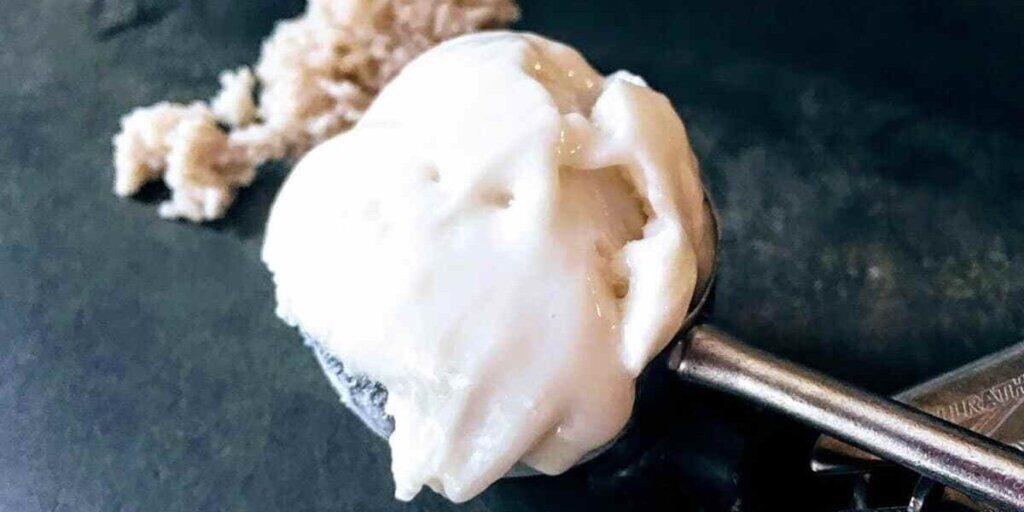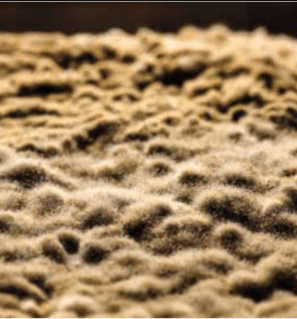Koji for a Touch of Sweetness: Koji Sorbet

The possibilities with koji are endless; cheese, condiments, bread, the list goes on! Let’s not forget about that sweet tooth. It might seem crazy, but koji sorbet is sweet and tangy, making a perfect treat for a warm summer’s evening. If you’ve mastered the simple homemade koji recipe, put your koji to work in this delicious, homemade sorbet.
The following is an excerpt from Koji Alchemy by Jeremy Umansky and Rich Shih. It has been adapted for the web.
Photo Credit: Anna Markow
Traditionally, koji was primarily used to power secondary applications and not typically utilized as a fresh ingredient. However, its inherent sweetness and touch of umami make it a fascinating sugar base to work with. Still, using fresh koji immediately for its base characteristics is a tough sell if you’re not producing at a relatively high level. That being said, we’ve found value in showcasing sweet koji as a driving ingredient. We think it’s worth your time, and you’ll understand once you have a ton of it made waiting for a purpose.
Not long ago the key to good eating—aside from basic nutrition—was using just enough sweetness to make something taste good, which is really a matter of finesse. Before refined sugar was readily available, folks depended primarily upon seasonal fruit and honey to include sweet treats in their diets. Today candy, soda, sweet desserts, and treats surround us everywhere we go, and this level of sweetness is what people expect when you tell them something is sweet or has sugar in it. What we’re talking about here, however, is how to add a touch of sweetness so your diners can experience the subtleties of the base flavor.

Landscape of spored-out koji (Aspergillus oryzae). Photo by Peter Larson.
The beautiful thing about long-grain rice koji grown with a sugar focused Aspergillus oryzae is that it gets quite sweet at the forty-eight-hour mark. It’s especially sweet if you run your incubator slightly hotter at 95°F (35°C) to encourage the generation of amylase enzymes. However, it’s still not as sweet as a natural syrup like honey. We find its sugar level and starch combination comparable to a ripe pear. To us, that means it’s wonderful but difficult to maintain the nuances of flavor without overwhelming it in an application.
Koji’s ability to add a touch of umami to make something delicious is especially important here. Think of all the savory crossovers that came into existence that were once considered strange but are now fairly accepted: tomato jam, bacon ice cream, miso caramel sauce. Koji made from protein-rich grains provides just enough to give flavor depth to sweet ingredients to bring everything together and make it wonderful to eat, changing your dessert game.
Koji for a Touch of Sweetness
Two forms of koji work well for immediate use: fresh as is, and amakoji (a thicker version of amazake). The fresh applications are just that, using koji as an ingredient without leveraging the enzymes or fermentation. Amakoji is used when the amylase has converted starch into sugar to make it sweet but hasn’t created notable acidity or even alcohol. To make it, all you need is 1 part koji, 1 part cooked grain, and 1 part water. Blend and let it sit out at ambient temperatures until it’s sweet and hasn’t soured. A couple of days is usually enough to get you there. You can also just use amazake.
ANNA’S KOJI SORBET
Anna Markow is a pastry chef in New York City with a wealth of understanding of techniques and methods as a result of years of dedication to the craft. She has an unbelievable palate that allows her to immediately parse out half a dozen different applications upon tasting something completely new. One thing that we’ve always been impressed by is her ability to marry flavors, especially if they’re not traditionally used in a dessert or pastry. Knowing what she can do, we shared sweet koji with her to see what she would come up with.
Koji is extremely versatile for pastry. The floral aroma and natural sweetness from a batch of jasmine rice koji gets creativity flowing toward complementary ingredients like berries and stone fruit, and, while using the koji to make ferments and amazake were also on the docket, capturing the flavor of the koji itself was something I knew I had to do to test its full potential.
In order to taste the true essence of koji, I created a recipe for koji sorbet, which, thanks to the starch in the rice, churns up the texture of a fine gelato. To achieve the right consistency and ensure the sorbet would stay soft enough to scoop, I found the Brix level and compared it with recipes for pulpy fruit sorbets with a similar sugar content, then adjusted for flavor as I blended, adding a small amount of water to ensure smoothness.
The sorbet is extremely sweet with a cultured tang, making it a surprising alternative to frozen yogurt, and a perfect foil for whatever accompaniments, fruit or otherwise, you might want to use. Anything from fresh sliced strawberries to tangy fermented blueberry pie to salty miso caramel sauce would play nicely with this sorbet. It also makes a very bracingly refreshing probiotic float when added to a glass of kombucha.
 Ingredients
Ingredients
- 500 g jasmine rice koji, fresh or frozen
- 50 g granulated sugar
- Up to 200 g water
- Salt, to taste
Procedure
- Place the koji, sugar, and a splash of water in a blender and begin puréeing on medium speed.
- Drizzle water into the blender slowly to help loosen the purée, then turn the speed up to high and continue adding water to make a thick but perfectly smooth and fluid paste.
- Blend in salt to taste.
- If blending has warmed the koji purée, chill it thoroughly before processing in an ice cream maker according to the manufacturer’s instructions.
- Remove to a plastic quart (liter) container and pack tightly, pressing plastic wrap over the surface before freezing completely.
Recommended Reads
Beat the Heat and Be Good to Your Gut: Dairy-Free Ice Cream Recipes
Recent Articles
Chances are, you’ve seen cattails growing on the edge of your local lake or stream at least once or twice. Instead of just passing these plants, try foraging for and cooking them to create delicious seasonal dishes! The following excerpt is from The New Wildcrafted Cuisine by Pascal Baudar. It has been adapted for the…
Read MoreGarlic mustard: while known as “invasive,” this plant can be consumed in its entirety and has great nutritional value. Plus, the garlic-flavor is a perfect addition to any recipe that calls for mustard! The following are excerpts from Beyond the War on Invasive Species by Tao Orion and The Wild Wisdom of Weeds by Katrina…
Read MoreOh, honeysuckle…how we love thee. If only there was a way to capture the sweet essence of this plant so we could enjoy it more than just in passing. Luckily, foraging and some preparation can help make that happen! Here’s a springtime recipe that tastes exactly like honeysuckle smells. The following excerpt is from Forage,…
Read MoreIntroducing…your new favorite brunch dish! This whole broccoli frittata is packed with fresh, wildcrafted flavors that are bound to help you start your day off on the right foot. The following is an excerpt from The Forager Chef’s Book of Flora by Alan Bergo. It has been adapted for the web. RECIPE: Whole Broccoli Frittata…
Read MoreWondering where to forage for greens this spring? Look no further than hedges, which serve as natural havens for wild greens and herbs! The following is an excerpt from Hedgelands by Christopher Hart. It has been adapted for the web. Food from Hedges: Salads and Greens Let’s start by looking at all the wild foods…
Read More









